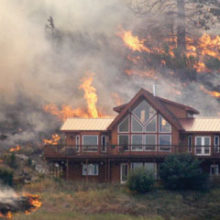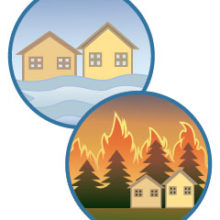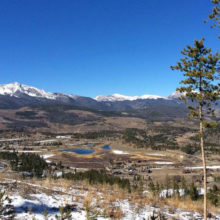- The six worst fire seasons since 1960 have occurred since 2000. Bigger wildfire seasons are associated with several factors: biomass fuels have risen, changing climatic conditions, and an increase of homes near forest lands.
- Wildfire protection costs have risen substantially. In the 1990s, the average cost of federal wildfire protection and suppression was less than $1 billion annually. Since 2002, the cost has averaged more than $3 billion per year.
- Wildfire protection now accounts for nearly half of the Forest Service annual budget.

Wildfires are getting larger and causing more damage. Headwaters Economics produced this report (PDF) as part of our long-term commitment to better understand and address why wildfires are becoming more severe and expensive.
The report also describes how the protection of homes in the Wildland-Urban Interface (WUI) has added to these costs and concludes with a brief discussion of solutions that may help control escalating costs.
We worked with Ross Gorte, Ph.D., to produce the report. Gorte, a retired Senior Policy Analyst at the Congressional Research Service, is now an Affiliate Research Professor at the University of New Hampshire.
Summary
The six worst fire seasons since 1960 have occurred since 2000. Bigger wildfires are generally the result of two factors. First, biomass fuels have risen, due to historic management practices—overgrazing that reduced grass cover and encouraged seedling growth; logging of the large pines that led to a less fire-tolerant understory; and aggressive fire suppression that eliminated the natural, low-intensity fires which reduced biomass levels. The other factor is changing climatic conditions—higher temperatures, widespread drought, earlier snowmelt and spring growth, and expanded insect and disease infestations.
Not surprisingly, wildfire protection costs have risen substantially. In the 1990s, the average cost of federal wildfire protection and suppression was less than $1 billion annually. Since 2002, the cost of federal wildfire protection and suppression has averaged more than $3 billion per year. Wildfire protection now accounts for nearly half of the Forest Service annual budget, and more than 10 percent of the budget for all Department of the Interior agencies. These figures do not include the $1-$2 billion spent by states on wildfire protection or an untold amount spent by local governments.
$3 Billion: The average annual cost of federal wildfire protection and suppression.
Figure 1. Federal Wildfire Appropriations to the Forest Service and Department of the Interior, 1994–2012
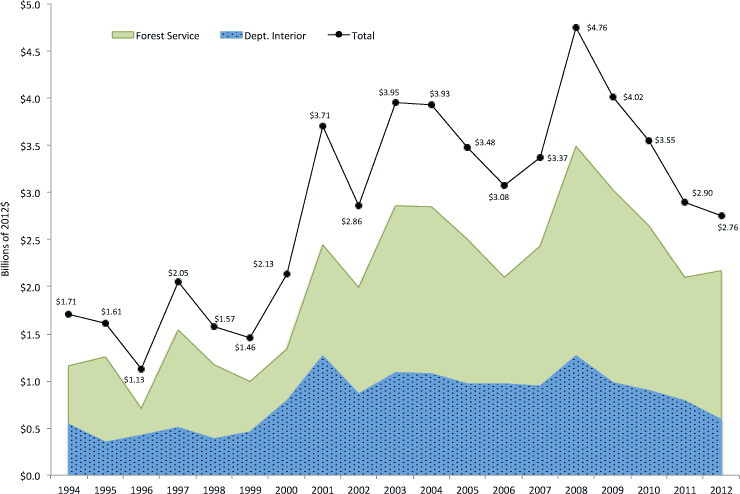
Source: Congressional Research Service Report RL33990, Federal Funding for Wildfire Control and Management.
This tripling of federal fire protection expenses is partly due to the more severe fire seasons, but it also results from building homes in and near forests and other wildlands that are at risk from wildfires—the Wildland-Urban Interface (WUI). While protecting the private lands of the WUI is largely a state and local responsibility, the development in the WUI has raised federal wildfire costs.
The presence of homes in the WUI affects federal firefighting strategies, and special efforts are often made to protect individual structures. The emphasis on protecting the WUI also diverts fire control from wildlands, thus increasing resource damages from wildfires. The increased fire control costs affect other Forest Service programs as well. The agency often must divert funds appropriated for other purposes, such as recreation management and watershed restoration, for firefighting. Such “borrowed” funds at a minimum delay other activities, and are not always repaid. Emphasis on WUI protection also has shifted fuel reduction efforts, limiting treatments that are needed to reduce the fuels that have accumulated in many non-WUI areas. Finally, the development of the WUI has increased the state and local demand for direct federal financial assistance in wildfire protection.
Wildfire threat and protection costs are likely to rise because of climate change and continued home development. Currently, the majority of private wildlands are undeveloped; only about 16 percent of the WUI in the West is now developed, and the remaining 84 percent is available for development. The potential development of these lands is a state and local responsibility, but their development would significantly increase the federal cost of wildfire protection.
To date, WUI protection efforts have focused largely on reducing fuels and making structures safer from fires. While these activities are necessary, they are not sufficient to control the rising cost of protecting the WUI from wildfires. Additional actions could include the increased development and dissemination of information for wildfire protection—increasing use of Firewise; mapping water sources and access routes; developing warning systems; and the like.
Federal incentives and disincentives could be used to expand WUI protection—federal assistance for local planning; eliminating the mortgage interest tax deduction for homes in the WUI; and more. State and local governments can also take responsibility for WUI development, using local zoning ordinances, building codes, set-back requirements, and more to protect the WUI; federal incentives could encourage such state and local responsibility. Finally, the federal government could act unilaterally, such as by requiring federal wildfire insurance for any WUI development near federal lands.
Figure 2. Wildfire Protection Funding on Federal Lands, Average FY2002–2012
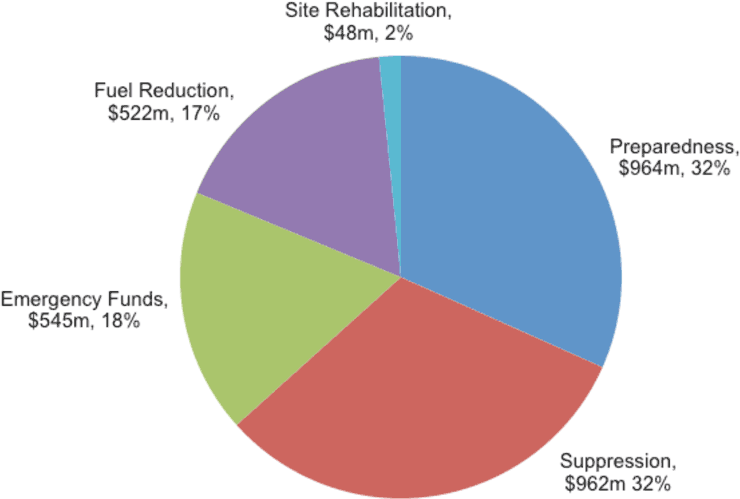
Source: Congressional Research Service Report RL33990, Federal Funding for Wildfire Control and Management.
Image “Firewise” by Monte Dolack used by permission, Monty Dolack Gallery, Missoula Montana.[/showhide]
